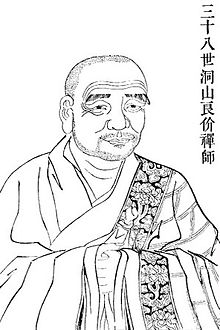SelfDefinition.Org
The Five Ranks of Dongshan Liangjie
a.k.a. Tōzan Ryōkai
(AD 807-869)

Comments by Thomas Cleary
Five Ranks, Three Roads, Three Falls, Three Leaks, Four Types of Different Kinds
Source (fair use): Translator’s Introduction, Book of Serenity (Shōyōroku) based on 100 koans of Dongshan Liangjie (807–869), compiled by Wansong Xingxiu (1166–1246), at shambhala.com
The Five Ranks
The five ranks may be viewed as a progression of stages of development or an analysis of different degrees of integration. In the first, called the relative within the absolute one practices detachment and interruption of mental habits, thereby gaining a measure of freedom and rest from compulsion and confusion. Detachment alone, however, is called a pit or a cave in Chan lore and shunned as a perilous indulgence without positive usefulness in itself. The second rank, therefore, called the absolute within the relative, is a state of merging with the environment, achieving a kind of unity of subject and object, sometimes likened to being like a mirror. This capacity to become totally absorbed in the present, however, while useful for breaking through the mental scattering caused by excessive attention to past or future, is also eventually shunned, called in Chan technical terminology "falling into the present," because it lacks the faculty of discrimination necessary for the person to be fully effective in the world. Thus the third rank, coming from within the absolute, does not remain in this equanimity, and turns to development of observation and action that leads to the fourth rank, arrival in the relative, and mastery of action in the world. The fifth rank, simultaneous arrival in both relative and absolute, refers to the consummation of harmony and integration of transcendence and being in the world. In the Book of Serenity this rank is represented as a mirror spinning, the dark back side of detachment and transcendence seeming to merge with the functioning bright side. This scheme of five ranks has early models in the Lotus of Truth (Saddharma-pundarika) and Flower Ornament (Avatamsaka) scriptures, both of which were widely read and highly esteemed in Chan circles.
The Three Roads
The three roads scheme also presents major stages of Chan practice and realization in general outline and echoes the previously mentioned three phases defined by Baizhang (Baizhang Huaihai) [Wikipedia] two generations earlier. The first road, called the path of the bird, is detachment, emptying the mind of preoccupations, and is referred to as "walking in the void". The second road, called the hidden path, goes further yet to the state of nonattachment even to detachment, where there is no consciousness of emptiness. The third road, called extending the hands, refers to returning to the world freely, liberated enough to be in the world without being conditioned by worldly things, and now able to complete the cycle of Buddhist life by reaching out to others to help them toward liberation.
The Three Falls
The three falls refer to progression beyond certain critical experiences and stages. The fall of the ascetic refers to transcending detachment; this is what is called "being a water buffalo," meaning acting in the world of differences. The fall of the noble means going beyond the experience of oneness and nondiscrimination, knowing the essence of the self but not clinging to it. The fall according to kind is referred to as not obliterating sense experience, to live in the realm of sense without being blinded or impeded by their experience.
The Three Leaks
The three leaks are impurities or defects in the knowledge of the Chan practitioner. The leak of views refers to clinging to a fixed position. The leak of feelings means retention of bias. The leak of words means excessive explanation that conveys a false sense of understanding that obscures the practical process; intellectual understanding, if exaggerated at the expense of actual application, can produce a false sense of having arrived at the end when one is really only on the threshold of beginning.
Four Types of Different Kinds
The scheme of four types of different kinds describes particular fields of experience and action. First, the different kinds of coming and going refers to all sense experiences, all verbalization, all mundane and spiritual states; this is in a sense the field of Chan practice. Second, the bodhisattva assimilating to different kinds refers to re-entering the world after having understood oneself, coming back to the mundane after having realized nirvana so as to help others. The "bodhisattva" is one dedicated to the ordinary and transcendental welfare of both self and others equally. Third, the different kinds for ascetics refers to re-entry into the world after having forgotten completely about everything in past present and future and having become independent. Fourth the different kinds within the Chan school, means going beyond absorption in the present moment, transcending all notions, even of "thusness" and acting in the midst of differentiations with no sense of either relative or absolute, being or nonbeing.
– Thomas Cleary [Wikipedia]
[ end ]